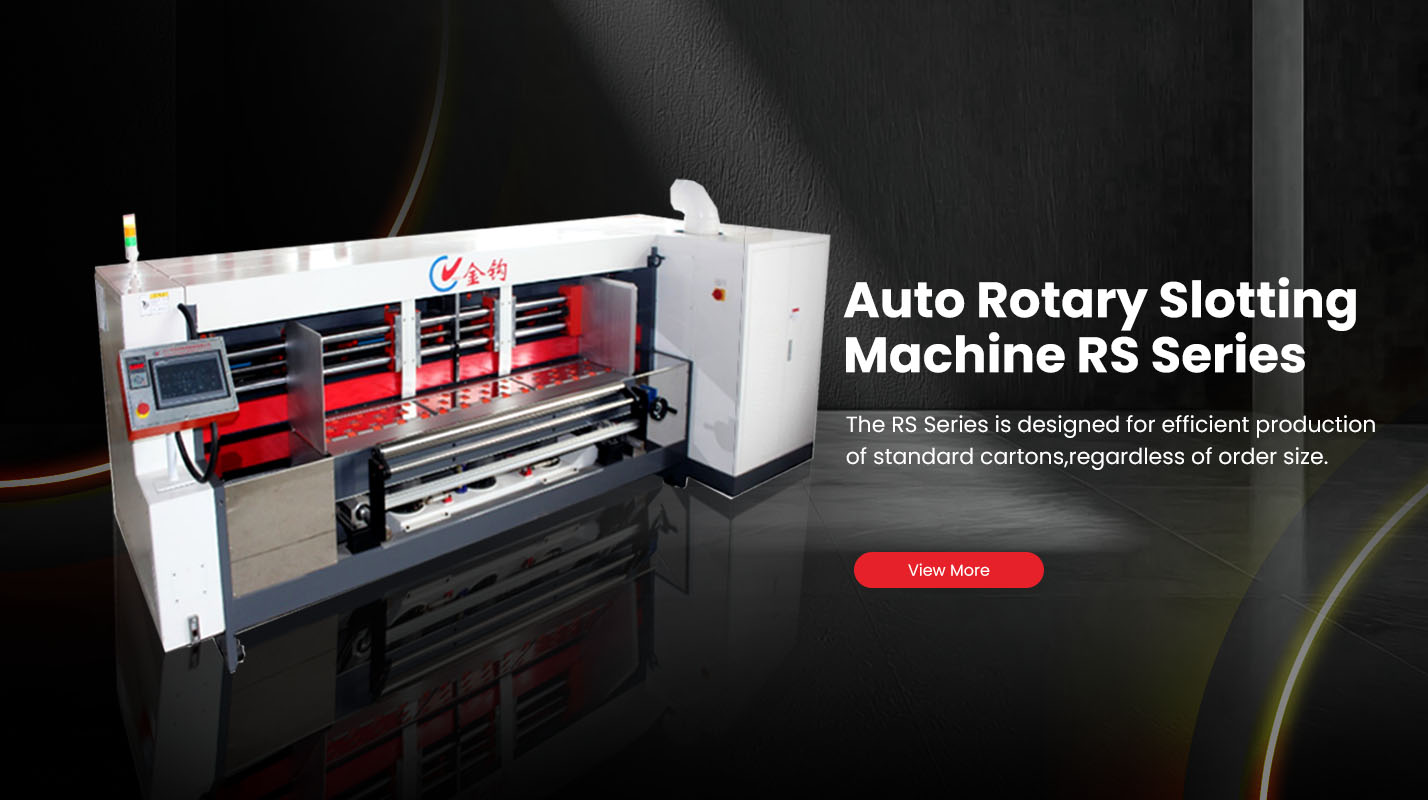Understanding The Role Of Rotary Slotter Machines In Carton Production
In the corrugated packaging industry, rotary slotter machines are essential equipment that directly determine the structure, precision, and performance of finished cartons. These machines perform one of the most critical steps in box manufacturing — slotting and creasing corrugated sheets to prepare them for folding and assembly.
As a global manufacturer of carton box forming and corrugated packaging equipment, JINGOUPACK designs high-efficiency rotary slotter machines that deliver exceptional accuracy, stability, and production speed for both small and large factories.
What Is a Rotary Slotter Machine?
A rotary slotter machine is a specialized piece of equipment used to cut and crease corrugated sheets into box blanks. It uses rotating knives and scoring wheels mounted on cylinders to create:
Slots: Vertical cuts that form the box’s flaps.
Creases: Indented lines that define fold points for assembly.
Unlike manual or flatbed slotting methods, rotary slotting ensures continuous, high-speed processing — making it a key component of modern corrugated box production lines.
1. The Function of Rotary Slotting in Carton Production
Rotary slotters prepare flat corrugated sheets into foldable blanks ready for gluing or stitching. Their main functions include:
Slotting: Cutting precise flap openings to define the box’s shape.
Scoring: Creating folding lines with adjustable depth.
Edge trimming: Ensuring clean, even edges along the board width.
Corner cutting: Shaping the box corners to prevent overlap during folding.
This combination of processes ensures that every box has accurate flaps, fold lines, and dimensions for perfect assembly and stacking performance.
2. Components of a Rotary Slotter Machine
A typical rotary slotter includes the following key sections:
Feeding unit: Feeds corrugated sheets into the slotting section.
Slotting and scoring cylinders: Rotating shafts equipped with knives and scoring wheels.
Positioning system: Controls knife spacing and scoring depth.
Transmission system: Coordinates motion between feed rollers and slotting drums.
Control panel: Digital interface for setup and monitoring.
In advanced models like those from JINGOUPACK, servo motors and PLC systems control knife positioning automatically — eliminating manual adjustments and ensuring micrometric precision.
3. How Rotary Slotters Work
Sheet Feeding: The corrugated sheet is fed into the machine by a motorized feeding unit.
Slotting: Rotary knives cut vertical slots according to the box design.
Scoring: Creasing wheels create fold lines at precise intervals.
Edge Trimming: The machine trims sheet edges for uniform width.
Discharge: Finished sheets exit the machine ready for folding or printing.
The continuous rotary motion allows high-speed operation — typically 100 to 150 sheets per minute — while maintaining excellent accuracy.
4. Advantages of Using Rotary Slotter Machines
High Precision and Consistency
Servo-controlled knives maintain consistent spacing and depth, ensuring all boxes have identical fold and flap dimensions.
Accuracy is maintained within ±0.3 mm, even during extended production runs.
Increased Productivity
Continuous rotary motion eliminates pauses between sheets, enabling rapid throughput.
Automatic knife adjustment reduces setup time from 20–30 minutes to under 3 minutes.
Reduced Waste
Precise cutting and scoring minimize material loss and prevent misaligned slots — a common issue with manual systems.
Flexible Operation
Digital control systems allow quick adjustment for different box sizes and corrugated flute types.
Operators can store and recall job settings, perfect for frequent order changes.
Durability and Reliability
JINGOUPACK’s rotary slotters use hardened steel blades and heavy-duty cylinders, ensuring long-term stability and low maintenance requirements.
5. Integration in a Complete Carton Production Line
A rotary slotter is typically placed after the slitter scorer and before the folding or gluing machine in a corrugated packaging line.
Production Flow Example:
Slitter Scorer: Cuts and creases the sheet width.
Rotary Slotter: Creates slots, creases, and trims edges.
Printer or Die Cutter: Adds printing or punching details.
Folder Gluer: Folds and glues the box.
Stacker: Collects finished boxes for packaging.
In automated systems, these stages are synchronized digitally to maintain precise timing and sheet positioning.
6. Manual vs. Automatic Rotary Slotters
| Feature | Manual Rotary Slotter | Automatic Rotary Slotter |
|---|---|---|
| Knife Adjustment | Manual handwheel | Servo motor digital control |
| Setup Time | 20–30 minutes | 2–3 minutes |
| Speed | 40–60 sheets/min | 120–150 sheets/min |
| Accuracy | ±1 mm | ±0.3 mm |
| Job Memory | None | Available |
| Labor Requirement | 2–3 operators | 1 operator |
| Best For | Small workshops | High-volume or multi-size production |
Automatic models, such as JINGOUPACK’s servo-controlled rotary slotter, provide unmatched flexibility and precision for factories managing multiple short runs.
7. Safety and Certification
Rotary slotter machines handle sharp blades and fast-moving sheets, so safety is critical.
Modern designs incorporate:
Emergency stop buttons at multiple points.
Protective guards with auto power cut-off.
CE-certified electrical components and overload protection.
All JINGOUPACK machines comply with CE and ISO standards, ensuring safe operation and smooth global export.
8. Maintenance Tips for Rotary Slotter Machines
Proper maintenance extends machine life and ensures consistent performance:
Clean dust and scraps from blades daily.
Lubricate shafts, gears, and chains regularly.
Check blade alignment and sharpness weekly.
Inspect scoring wheels for wear or uneven pressure.
Replace worn parts proactively to avoid downtime.
JINGOUPACK offers remote diagnostic service and spare parts supply for international clients to keep machines operating at full efficiency.
9. Applications Across the Packaging Industry
Rotary slotter machines are essential for producing:
Shipping cartons and corrugated cases.
Food and beverage packaging.
E-commerce delivery boxes.
Industrial and electronics packaging.
They are suitable for both standard RSC boxes and custom-sized cartons, making them a cornerstone of modern packaging plants worldwide.
Conclusion
The rotary slotter machine plays a vital role in transforming flat corrugated sheets into precisely engineered carton blanks.
Its speed, accuracy, and automation capabilities make it indispensable for efficient, high-quality box production.
Whether for mass production or flexible short runs, rotary slotters designed by JINGOUPACK combine servo-driven precision, CE-certified safety, and energy-efficient performance — helping manufacturers achieve higher productivity with lower waste.
Investing in the right rotary slotter means investing in long-term reliability, consistent product quality, and a competitive edge in the global packaging market.





